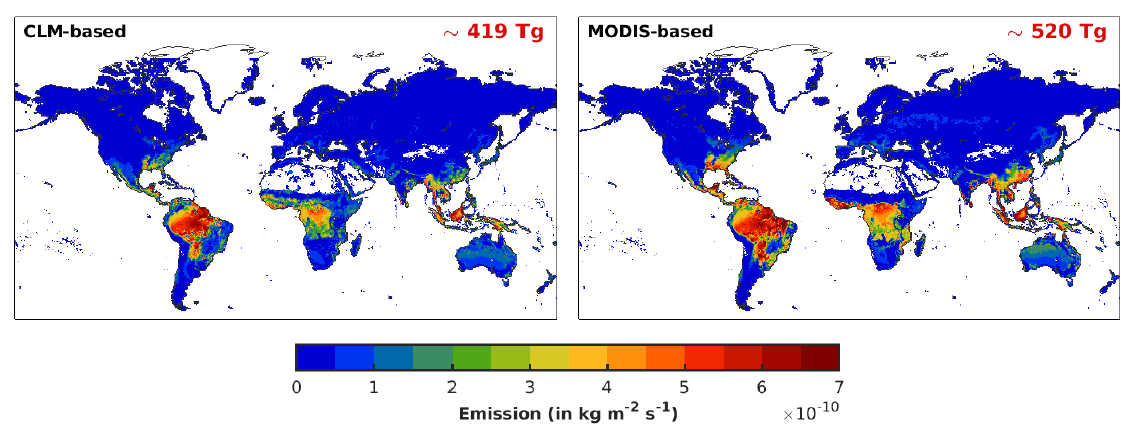MEGAN-MOHYCAN isoprene emissions accounting for space-based land cover changes [ALBERI dataset]
View the data
The figure displays the global mean isoprene emissions (in kg m-2 s-1) averaged over 2001-2018 and the corresponding total global emission is given inset (in Tg of isoprene).

Download
Below we provide global monthly biogenic isoprene emissions (in kg m-2 s-1) at 0.5°×0.5° between 2001 and 2018 in NetCDF format: 720 longitudes from 179.75°W to 179.75°E, 360 latitudes from 89.75°S to 89.75°N.
ALBERI - GFWMOD
The effects of CO2 inhibition and soil moisture stress are neglected (γCO2 =1 and γSM =1; Guenther et al., 2012).
About the ALBERI dataset
The ALBERI dataset is a bottom-up inventory of isoprene emissions generated by the MEGANv2.1 model (Guenther et al., 2006; 2012) coupled with the multi-layer canopy environment model MOHYCAN (Müller et al., 2008) and driven by ECMWF ERA-Interim meteorological fields. It is produced using 16 Plant Functional Types (PFTs) maps compatible with the Community Land Model version 4 (CLM4) derived from satellite-based Land Use/Land Cover (LULC) datasets. The emission potential is calculated based on PFT-dependent emission factors provided in Guenther et al. (2012) weighted by the fractional areal coverage of the corresponding PFT class of a grid cell.
The LULC datasets are based on the MODIS PFT dataset (MCD12Q1 v006; Friedl et al., 2019) and are adjusted to match the continuous tree cover fields of the Global Forest Watch (GFW v.1.6, Hansen et al. 2013). The GFW data are based on Landsat data available at fine spatial resolution (30×30 m2).
The resulting dataset, GFWMOD, is annually updated between 2001 and 2018 and is described in detail in Opacka et al., Global and regional impacts of land cover changes on isoprene emissions derived from spaceborne data and the MEGAN model, Atmospheric Chemistry and Physics, submitted. This study indicates that the fine-resolution continuous tree cover fields provided by the GFW database in combination with discrete LULC distributions (such as those of MODIS) are presently the most promising option for constraining LULC in biogenic isoprene emission models.
The ALBERI-GFWMOD inventory was developed in the frame of the ALBERI project, funded by the Belgian Science Policy Office (BELSPO), as part of the STEREO III Earth observation programme.
- Citation: Opacka, B., & Müller, J.-F. (2021). MEGAN-MOHYCAN global isoprene emissions accounting for space-based land cover changes [ALBERI dataset] [Data set]. Royal Belgian Institute for Space Aeronomy (BIRA-IASB), Brussels, Belgium. https://doi.org/10.18758/71021062.
Licence: CC-BY
Other isoprene emission datasets based on MODIS PFT and CLM
Two other datasets of isoprene emissions were developed and assessed in Opacka et al. They are available for download and use LULC PFTs from:
- MODIS: annually updated (2001-2018), based on the MODIS PFT (MCD12Q1 v006; Friedl et al., 2019). The 16 PFTs are obtained following the methodology applied for GFWMOD, described in Opacka et al., submitted.
MODIS-based
- CLM: static map representative of the present day vegetation cover and compatible with the CLM4, available in the standard offline version of MEGANv2.1 model (Lawrence and Chase, 2007; Lawrence et al., 2011).
CLM-based

References
- Beck, H.E., Zimmermann, N.E., McVicar, T.R., Vergopolan, N., Berg, A., and Wood, E.F.: Present and future Köppen-Geiger climate classification maps at 1-km resolution, Sci. data, 5, doi:10.1038/sdata.2018.214, 2018.
- Friedl, M., and Sulla-Menashe, D.: MCD12Q1 MODIS/Terra+Aqua Land Cover Type Yearly L3 Global 500m SIN Grid V006, NASA EOSDIS Land Processes DAAC, doi: 10.5067/MODIS/MCD12Q1.006, 2019.
- Guenther, A. B., Jiang, X., Heald, C. L., Sakulyanontvittaya, T., Duhl, T., Emmons, L. K., and Wang, X.: The Model of Emissions of Gases and Aerosols from Nature version 2.1 (MEGAN2.1): an extended and updated framework for modeling biogenic emissions, Geosci. Model Dev., 5, 1471-1492, doi: 10.5194/gmd-5-1471-2012, 2012.
- Hansen, M.C., Potapov, P.V., Moore, R., Hancher, M., Turubanova, S.A., Tyukavina, A., Thau, D., Stehman, S.V., Goetz, S.J., Loveland, T.R., and Kommareddy, A.: High-resolution global maps of 21st-century forest cover change., Science, 342, 850-853, doi:10.1126/science.1244693, 2013.
- Lawrence, P. J. and Chase, T. N.: Representing a new MODIS consistent land surface in the Community Land Model (CLM 3.0), J. Geophys. Res., 112, doi:10.1029/2006JG000168, 2007.
- Lawrence, D.M., Oleson, K.W., Flanner, M.G., Thornton, P.E., Swenson, S.C., Lawrence, P.J., Zeng, X., Yang, Z.L., Levis, S., Sakaguchi, K. and Bonan, G.B., and Slater, A. G.: Parameterization improvements and functional and structural advances in Version 4 of the Community Land Model, J. Adv. Model. Earth Syst., 3, M03001, doi:10.1029/2011MS00045, 2011.
- Müller, J.-F., Stavrakou, T., Wallens, S., De Smedt, I., Van Roozendael, M., Potosnak, M. J., Rinne, J., Munger, B., Goldstein, A., and Guenther, A. B.: Global isoprene emissions estimates using MEGAN, ECMWF analyses and a detailed canopy environment model, Atmos. Chem. Phys., 8, 1329-1341, doi: 10.5194/acp-8-1329-2008, 2008.
- Poulter, B., Ciais, P., Hodson, E., Lischke, H., Maignan, F., Plummer, S., and Zimmermann, N.E.: Plant functional type mapping for earth system models, Geosci. Model Dev., 4, 993-1010, doi: 10.5194/gmd-4-1-2011, 2011.






